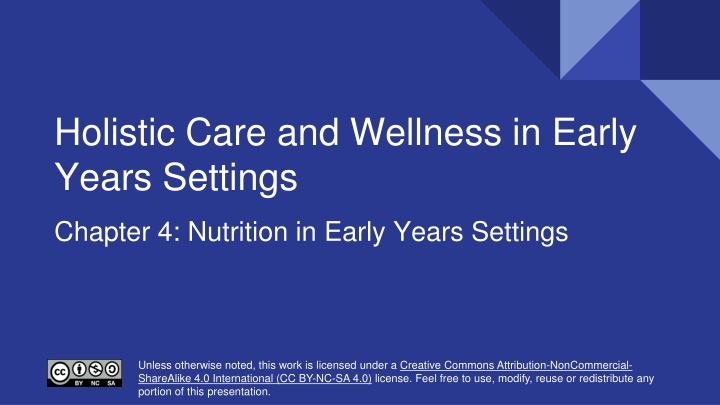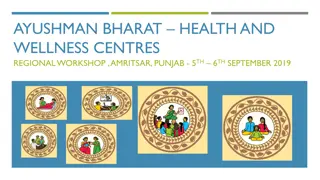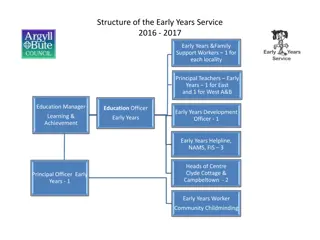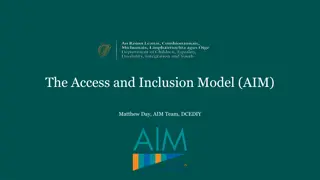Holistic Care and Wellness in Early Years Settings
Explore the essential nutritional principles and practices for infants, toddlers, preschoolers, and school-agers in early childhood settings. From prenatal nutrition to toddler feeding practices, learn about supporting healthy eating habits and fostering a nurturing mealtime environment. Understand the importance of collaboration with families, menu planning based on Canada Food Guide recommendations, and promoting sustainable dietary practices for holistic care and wellness.
Download Presentation

Please find below an Image/Link to download the presentation.
The content on the website is provided AS IS for your information and personal use only. It may not be sold, licensed, or shared on other websites without obtaining consent from the author.If you encounter any issues during the download, it is possible that the publisher has removed the file from their server.
You are allowed to download the files provided on this website for personal or commercial use, subject to the condition that they are used lawfully. All files are the property of their respective owners.
The content on the website is provided AS IS for your information and personal use only. It may not be sold, licensed, or shared on other websites without obtaining consent from the author.
E N D
Presentation Transcript
Holistic Care and Wellness in Early Years Settings Chapter 4: Nutrition in Early Years Settings Unless otherwise noted, this work is licensed under a Creative Commons Attribution-NonCommercial- ShareAlike 4.0 International (CC BY-NC-SA 4.0) license. Feel free to use, modify, reuse or redistribute any portion of this presentation.
Learning Outcomes In this chapter, we will: Describe appropriate nutritional principles and practices for infants, toddlers, preschoolers and school-agers. Ability to develop menu for licensed child care setting by embedding Canada Food Guide recommendations. Understand sustainable dietary practices to support care for humans, the land, and more than human others.
4.1 Prenatal Nutrition & Infant Feeding Practices Nutrition during early years has significant effects on a child's development. Public health mandates educate individuals on proper nutrition during pregnancy and childbirth. Educators support families during pregnancies and provide resources. Child care centers require written nutritional plans for children under one year old, developed with families for consistency. Photo by Sarah Chai, Pexels License.
4.2 Breastfeeding & Bottle Feeding Breastfeeding and Bottle Feeding: WHO recommends exclusive breastfeeding for 6 months and continued breastfeeding until age 2 or beyond. Early years settings should support breastfeeding and provide resources. Effective communication with families is important for bottle feeding and creating a nurturing feeding environment. Milk and Milk Alternatives and Introducing Solids: Respect and support families' choices on breastfeeding, milk alternatives, and solid food introduction. Collaborate with families for consistent nutrition at home and in the early years setting. Develop written plans for infants, including milk alternatives, allergies, and solid food introduction.
4.3 Toddler Nutritional Practices Toddlers are transitioning to more independent feeding practices and enjoy autonomy over their eating habits. Finger foods are important for toddlers to gain autonomy in feeding, and educators collaborate with families for consistent practices between home and early years settings. Family-style meals with educators modeling healthy eating practices create a nurturing environment for social interaction and learning. Encouraging children to sit while eating, engaging in conversations, and involving them in mealtime tasks promotes social and literacy skills. Photo by Naomi Shi, Pexels License.
4.4 Preschool Nutritional Practices Preschoolers in early years settings exhibit increased independence during snack and meal times. They actively participate in setting up the snack table, scrape off their dishes, and serve their own food. Mealtime conversations promote social skills, while discussions may include outside events and cultural practices. Collaboration between educators and families ensures the fulfillment of children's nutritional needs. Preschoolers may display food preferences and aversions, but it is important to offer a variety of foods and textures repeatedly to build trust and establish healthy eating habits. Engaging preschoolers in food preparation activities contributes to their enjoyment and educational development. Photo by RDNE Stock Project, Pexels Licence
4.5 School Age Nutritional Practices Transition and Challenges: Transitioning to kindergarten brings changes in nutritional practices. Challenges arise for families facing food insecurities and developing self-help skills. Educator Awareness and Support: Educators address challenges with school-age dietary practices. Some schools implement programs for nutritious snacks and meals to support children's nourishment and engagement. Food Inadequacy, Shaming, and Cultural Celebrations: Addressing food inadequacy and preventing shaming among peers. Celebrating cultural values and traditions, promoting exposure to diverse foods in early years settings.
4.6 Role of the Educator Positive Role Modeling in Early Years Settings: Educators' powerful influence on children's nutritional guidance. Importance of refraining from body size and dieting conversations in front of children. Preventive Measures in Learning Spaces with School-Age Children: Educators as role models in promoting inclusivity and addressing body shaming. Addressing the impact of social media and engaging in parent education on diversity and inclusion. Resources for Reducing Weight Bias in School-Age Children: Helpful resources to support school-age children in reducing weight bias. Reviewing webpages for valuable information on supporting children's well-being.
4.7 Canadas Food Guide Canada's Food Guide provides information on food groups, healthy eating practices, and resources for making nutritious choices. It serves as a foundation for educators and dietary planners in early years settings. Cultural food traditions can be incorporated to create a more inclusive environment. The guide is available in multiple languages, and additional support is provided for children with specialized diets. Collaboration among educators, administrators, families, therapists, and consultants ensures individualized care and smooth transitions for children. Photo by Ella Olsson, Pexels License.
4.8 Menu Development Menu Development: Menus created by dietary planners and administrators. Menus reviewed by Ministry of Education and Public Health Agencies. Cultural diversity considered in menu planning. Regulation and Guidelines: Licensees provide meals and snacks for children. Drinking water always available. Meals and snacks meet Health Canada's food guide. Diversity and Cultural Relevance: Menus rotated every 4-6 weeks with seasonal adjustments. Menus posted for tracking allergies and illnesses. Collaboration with families for cultural food practices and recipes.
4.9 Dietary Restrictions Dietary Restrictions and Inclusion: Collaboration with families to support dietary restrictions. Clear communication of dietary restrictions to educators and staff. Anaphylactic plans developed for children with food allergies. Compliance with Regulations: Menus posted in food preparation and visible areas. Retention of menus for tracking allergies and illnesses. Post food allergies and restrictions in cooking and play areas. Allergies and Anaphylactic Plans: Posting of food allergies and restrictions in all accessible areas. Availability of anaphylactic plans and medication. Training provided to employees, volunteers, and students on anaphylactic plans. Photo by Tom Hermans, Unsplash License.
4.10 Outside Food & Safe Food Handling Food Provided by Families: Communication between families and the early years setting regarding outside food. Policies to prevent cross-contamination for children with allergies. Request for labeled food with listed ingredients. Specialized Diets and Dietary Restrictions: Collaboration with families to accommodate dietary restrictions. Incorporation of specialized diets into the menu. Offer of substitutes and alternatives for children with specific dietary needs. Safe Food Handling and Certification: Food labeling and storage guidelines for food brought from outside. Requirement for dietary planners and supervisors to have safe food handling certification. Potential requirement for educators to have safe food handling certification.
4.11 Sensory Play & Slow Food Sensory Food Food for sensory play is a topic of debate among early years educators. It involves using items like rice, lentils, beans, and pasta to provide sensory experiences for young children, helping them become more accepting of different foods and textures. However, there are concerns about food insecurities and the ethical use of food for play. Slow Food Children are often rushed through daily routines, both at home and in early years settings. It's important to allocate sufficient time for snacks and meals to allow children to appreciate food and engage in meaningful conversations. Activities like gardening and food preparation provide valuable learning experiences and foster a connection to nature. The slow food movement promotes health and well-being by emphasizing the journey of food from farm to table.
4.12 Sustainable Food Practices Early years settings have a vital role in promoting sustainability, especially in relation to food practices, nutrition, and food waste. Educators play a crucial role in modeling sustainable practices and teaching children about the food they consume. It is important for children to understand their connection to the environment and the responsibilities they have as future citizens. Recognizing the role of more than human actors in supporting well-being and respecting the land and ecosystems is essential in early childhood education. Photo by Kindel Media, Pexels License.























